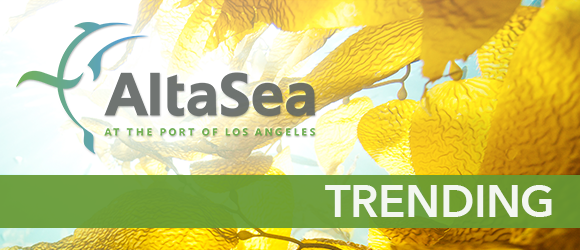
Marine Science Could Renewable Energy Be Stored in Balloons in the Ocean? (Smithsonian) Though solar and wind energy are becoming more and more efficient, storing this energy — for use when the sun is not shining or the wind not blowing — is a challenge. Underwater compressed air energy storage could be a low cost and environmentally-friendly answer. In this approach, excess energy from solar or wind charges an air compressor, filling large balloons in the ocean. This article explains how the process uses the natural power of the ocean for even greater efficiency, proving that balloons aren’t just for parties. Here’s the Most Complete Ocean Floor Map Ever Made (Gizmodo) NASA is at it again, this time providing us with the most complete, unified view of the Earth’s seafloor to date. Though NASA previously released a detailed map of the seafloor, including an interactive Google Earth map, this new image gives a quick glance of the entire planet. Instead of using sonar, which is the traditional — and expensive — way of generating a detailed map, NASA created it using satellite data to look for gravity anomalies as measured by sea surface heights. Hydro Dam Boom Threatens a Third of the World’s Freshwater Fish (The Guardian) Ecologists warn that new large hydro dams in the Amazon, Mekong and Congo could devastate freshwater biodiversity in these tropical river basins. These areas previously didn’t have dams built because of their remoteness, but new demands for clean electricity and roads to previously inaccessible areas has led to plans for over 450 new dams. Dams reduce fish diversity by blocking movements that enable migratory species to complete their life cycles.
Sustainable and Innovative Business Aquaponics at Heart of ‘Blue Revolution’ (Agriview) There are no cows on this Midwest farm, but there is plenty of protein. The University of Wisconsin has partnered with designers of aquaponics systems to develop the first Aquaponics Innovation Center. Aquaponics is a hybridization of aquaculture and hydroponics that combines indoor rearing of fish with soil-less plant production. According to the University of Wisconsin, “harvest of wild-caught, ocean fish plateaued over a decade ago, so any increases in production of protein-rich food-fish must come from farms. When grown in sustainable, economical and ecologically responsible manners, farm-raised fish can provide the least-cost form of dietary protein.” SmartFin Gathers Ocean Data While Users Surf (Gizmag) While buoys and autonomous vehicles gather data to monitor the ocean’s deep waters, scientists still need information on the water close to the shore — an area too shallow or turbulent for the usual tools. Enter SmartFin, a new surfboard fin that allows surfers to help collect data. The fin acts like a regular surfboard fin but is equipped with tools to allow it to measure salinity, pH and water temperature. Surfers can then upload the data from an app on their smartphone that connects to the fin via Bluetooth. Once validity testing is complete a commercial roll-out should follow.
Education Why STEM’s Future Rests In The Hands Of 12-Year-Old Girls (TechCrunch) A recent report by the Organisation for Economic Co-operation and Development (OECD) found that top-performing girls lag behind top-performing boys in math and science, and suggests the possible reason is that girls report lower levels of confidence in their abilities. They found that between 9-12 years old there is a shift in girls’ math and science scores and girls begin to opt out of higher-level courses, thus reducing their chances to pursue STEM careers like marine science. How do we turn the tide of this trend? The report provides recommendations on how to address the main causes that prevent girls from entering STEM fields.
Community San Pedro Waterfront, LPG Tanks Carry Over Into New Year of Port of LA Meetings (Daily Breeze) The first meeting of the year for the LA harbor commission drew arguments on both sides of a long held battle between advocates for building the waterfront into a tourist destination and those who argue the Port needs to remain focused on growing its container shipping business. At the heart of the Waterfront argument is the Bridge to Breakwater plan, which calls for increased development, including a new venue that would replace the Ports O’Call Village. Another hot button issue, the presence of LPG tanks near port property, added to the lengthy discussions during the meeting. Tear Down a Freeway? In Southern California? It Could Happen (LA Weekly) A plan to remove a one-mile section of the Terminal Island Freeway in Long Beach and replace it with park space is slowly moving forward, now that the Long Beach City Council has voted unanimously to green-light an environmental study of the freeway closure. Currently about half of the vehicles that use the section of freeway are trucks picking up goods from the port. Scientist: We Should Just Let the LA River Flood Sometimes (Curbed Los Angles) In a previous issue of AltaSea: Trending we shared how some farmers are considering letting their land flood to help refill the water table. This same principle is now being recommended for sections of the LA River. The current concrete channel takes water to the ocean rather than allowing it to be absorbed into the ground, which would boost LA’s groundwater resources. A team of local firms has already created a plan that would allow parts of the Piggyback Yard site in Lincoln Heights to flood. Some are concerned, however, that flooding this area will result in the flooding of basements of many downtown buildings. www.altasea.org Subscribe to AltaSea: Trending Privacy Policy | Unsubscribe AltaSea at the Port of Los Angeles
|
